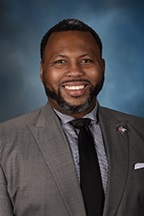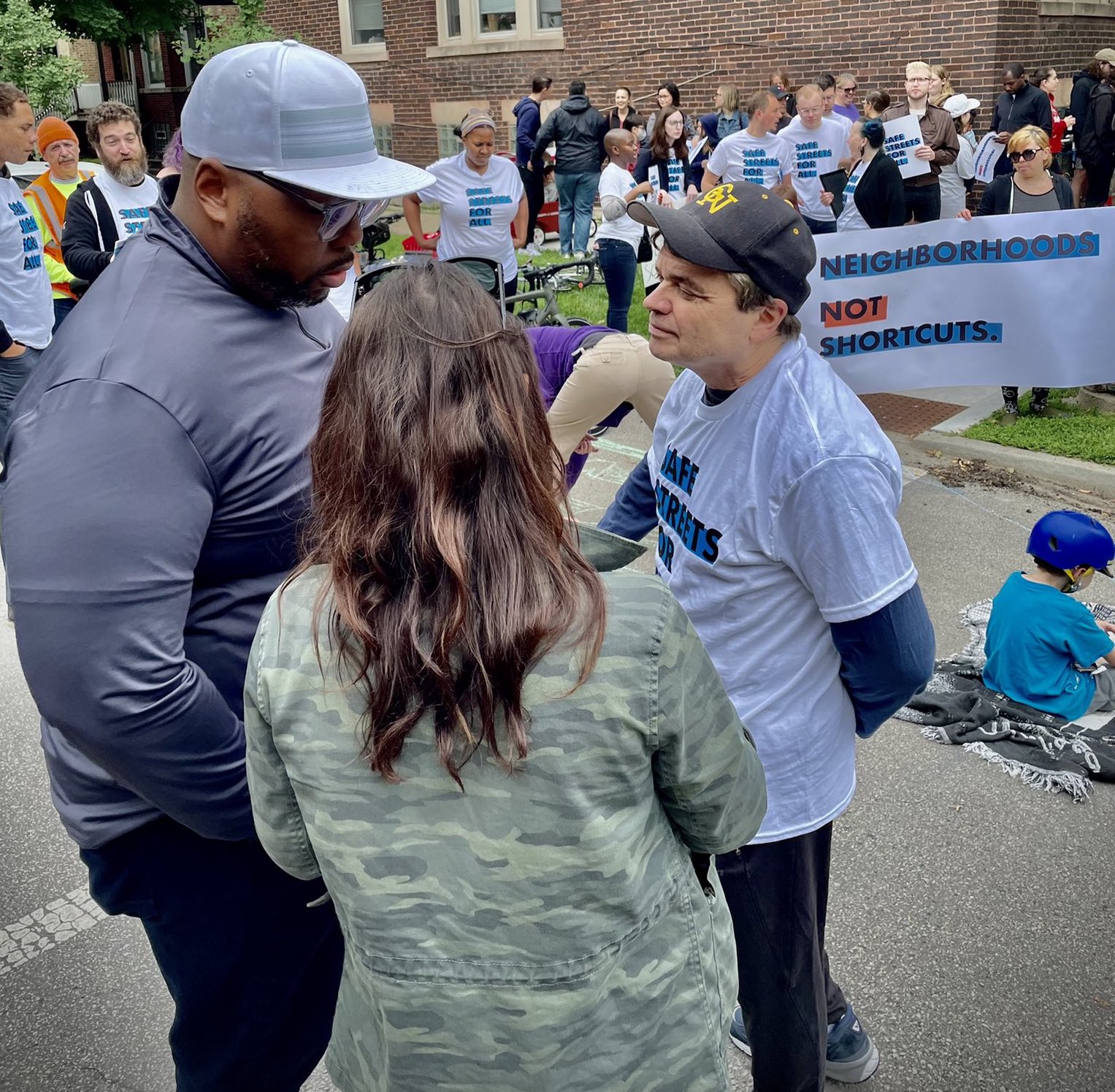Illinois state representative Kambium “Kam” Buckner (IL-26), representing parts of the South Loop, Gold Coast, Bronzeville, Hyde Park, Kenwood, Woodlawn, and South Shore, recently announced his plans to run for mayor of Chicago. Buckner is also the chair of the Illinois Black Caucus. Buckner caught my attention at the huge Safe Streets for All rally on June 13 in Lincoln Square and Uptown because he was one of the few Black people in attendance. He's also recently been popping up in Twitter conversations about cyclist safety.

Courtney Cobbs: The term "safe streets" means different things to different people
Kam Buckner: When I hear safe streets, I envision multi-modal streets that enable people to travel without the fear of experiencing injury or death. I think about what should have existed so that we wouldn’t have to mourn the loss of Rafi, Lily, and Ja'lon. I think about our city government taking the lead to ensure our thoroughfares are safe and accessible, no matter what mode you choose.
CC: Can you expound on accessibility, especially as it relates to people with disabilities or other mobility challenges? What could the city do to make it more accessible?
KB: We have adhered to an old school form of infrastructure development that’s been focused on cars. That leaves out a lot of people. The city needs to lead on being different and bold. We’ve talked about a protected bike grid, protected intersections, and navigating the sidewalks in the winter. We have to be able to move to a new space where all of these pieces are integrated, along with transit as well.
CC: What would you do differently on transportation as mayor?
KB: I have committed to doing the work to create a protected bike lane network. It will require hard barriers and protected intersections. Right now our bike infrastructure doesn’t meet standards in other parts of the world that have lower rates of traffic fatalities. I want to create a Bike Lane Integrity Unit at the Chicago Department of Transportation. Long-term we need to commit to improving our transit infrastructure. We need to be able to work with the state and federal government to manage freight traffic. I would work to remove semis from residential streets. I’m inspired by Barcelona’s Superblocks and would like to see something like that in Chicago. Lastly, we need to get CTA back up and running at full capacity. Chicagoans need to be able to depend on the CTA to get around. People’s travel patterns have changed as a result of COVID and we need our transportation system to reflect that while also moving us in the right direction on traffic fatalities, climate change, liveability, etc.
CC: Oftentimes when cities or neighborhoods become more liveable, the city or neighborhood becomes more desirable which attracts newcomers which tends to lead to rent increases/ gentrification? What protections will you take to mitigate this?
KB: Great question. We do have an obligation to protect folks and allow them to stay in their neighborhoods of choice. My team has been in communication with the around the city who are at risk of displacement based on proposed developments. Most notably we’ve been working with residents who live around the planned Obama Presidential Library site. On a broader scale, we need to make sure we’re not giving developers the easy way out by throwing a couple of dollars to skirt their responsibility to build affordable housing. How do we bring people to the table and make sure residents have a seat at the table to ensure they have a voice?
My campaign will be coming out with a plan for the real estate transfer tax and homelessness. The mayor has an opportunity to revamp the entire program. Right now none of the real estate transfer tax funds goes towards housing issues. Currently the funds are split between the CTA and the city’s general fund. I’d like to see these funds address housing overcrowding, homelessness, and housing insecurity. We have the resources to get the ball rolling; we just need a commitment to city hall. We can have balanced redevelopment without pushing people out.
CC: We’ve talked about your desire to see a protected bike lane network in the city. What’s your vision for transit?
KB: Chicago’s mayor has a lot of power over the CTA. We need a commitment from City Hall to improve transit. Chicagoans have to ask themselves if we’re okay with leadership that does the bare minimum instead of pushing the envelope. We should ask ourselves if we’re okay with being dubbed the Paris of Mississippi vs being compared to Paris, France [which has made a lot of progress in becoming a more bike-friendly and liveable city]. This isn’t to talk down on Mississippi but we need bold leadership that gives us a strong footing on a global dimension.
I’m acutely aware that we can do better on transit. I grew up on the Far Southside and I had a 40 minute bus commute just to reach the Red Line. The Red Line extension won’t be completed for some time and there’s an opportunity to improve transit service on the Far Southside well before the extension is finished. One opportunity is to improve Metra services. Another opportunity is to have systemwide fare integration with Metra.
Today, I stood with Chicagoans from across the city to honor the lives of Rafi & Lily and to demand real action on making our streets safe. We have a responsibility that we have fallen short on. Thank you @MattMartinChi & @RepMikeQuigley for your leadership. Let’s get it done. pic.twitter.com/WMVK4r0zjt
— Rep.Kam Buckner ✶ ✶ ✶ ✶ (@RepKamBuckner) June 12, 2022
CC: Speaking of Paris, many of their changes to create more space for people and bike lanes initially and likely still do frustrate drivers. What are your thoughts?
KB: For a mayor to get this right, it likely will be unpopular initially. If we want to lead, unpopular decisions will have to be made.
In a former role I worked for the mayor of New Orleans and we did some work around the Lafitte Greenway. The Greenway is a 2.6 mile linear park in the heart of New Orleans that provides a green space and a safe route for people to walk and bike to destinations. Initially folks wanted it to be a pedestrian interstate. We pushed back and pushed for the vision that created the Greenway.
Here in Chicago we need to have the conversation about Lakeshore Drive and how to repurpose it for the next generation. At the same time, many Chicagoans have been involved in conversations with CDOT and the city, and the plans don’t go anywhere. A small group of people shouting against the changes has led to plans being watered down or just abandoned. People are tired of committees and plans. We need to sit down and commit to changing the way that we do business. We need to get to work on building the type of infrastructure that we need as a city. I think everyone can get behind a Chicago that is more livable, bikeable, sustainable, safer, and makes us the envy of other places in the world. This city should be leading the conversation on liveability, biking, and transit and showing our smaller regional cities how it’s done.
CC: So, what makes you different from other mayoral candidates when it comes to transportation?
KB: I have a track record in the Illinois General Assembly on supporting equitable, accessible, and safe transit. I will hold that record against any of the other candidates.
I’ve been fortunate to live in a number of great cities. I’ve fought for public safety from an absence of crime stand point. You’ll see many mayoral candidates bring up crime. I’ve fought for educational resources. There are great cities in the world that may not be as safe as you want from a crime standpoint and they may have issues with schools. There are also great cities in the world that don’t have equitable, accountable, and open transportation. I will work tirelessly on all three of these issues. These are the promises worth keeping.
CC: What would you say to those who may have concerns about your DUIs?
KB: I have been very open about my mistakes and missteps in the past. I have taken these missteps seriously and I have not skirted responsibility. I am more than willing to discuss these mistakes with anyone who wants to discuss them. Over the years that have passed since my DUIs, I’ve been in conversation with constituents, colleagues, staff, etc about this issue.
This DUI has influenced my transportation advocacy in the years since. It’s also made me a more balanced and intentional legislator.
CC: Speaking of the state, one of the transportation issues Chicago faces is not having full control over its streets. As I’m sure you’re aware, a number of streets are under the control of the Illinois Department of Transportation. What would you do as mayor to tilt the scales a bit more towards local/city control?
KB: The interesting thing about our government is that as big and mighty as Chicago is, a good amount of money and power exists 200 miles south in the middle of a cornfield. I’m the only one in this race who has ever gotten anything done in Springfield. My track record will serve me well as we attempt to take control of our streets. I believe my relationships within the executive and legislative branch will assist me with bringing a plan to Springfield that will put Chicago on the right track.






